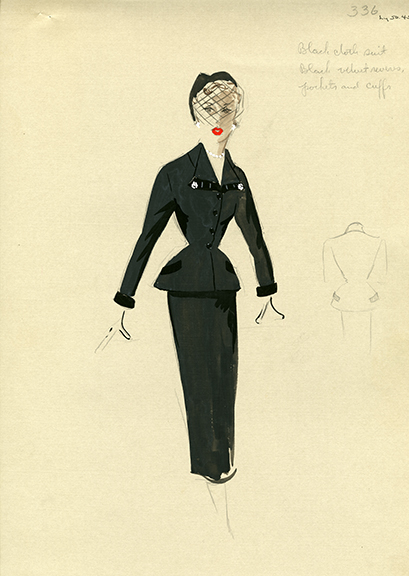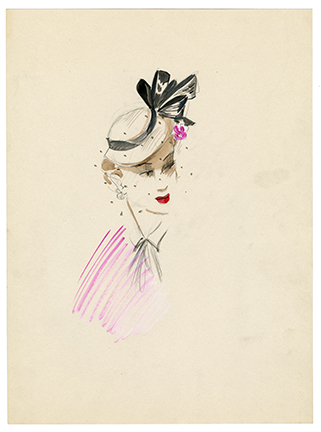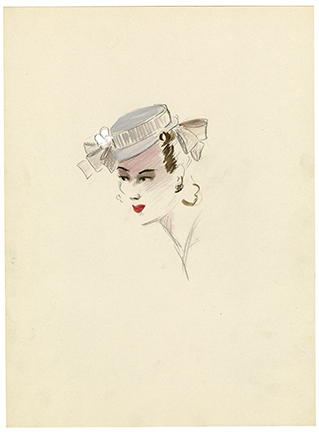
Born in 1886 in Vienna, Austria, the petite (4″ 10′) dynamo, Henrietta Kanengeiser would grow up to become one of the leading figures in American fashion for more than four decades. After a fire destroyed their Vienna home in 1892, Henrietta’s family relocated to the Lower East Side of New York City—Henrietta the second of seven children.
By her early twenties, Henrietta had changed her name, going by her sobriquet ‘Hattie’ and the last name Carnegie, an homage to the wealthiest man in the country, industrialist Andrew Carnegie. Perhaps she saw herself cut from the same cloth as the steel tycoon, for Hattie certainly did not lack in ambition! She began working at age twelve and by eighteen, she was working as a messenger for the department store R.H. Macy’s. With partner Rose Roth, Hattie opened a boutique in 1909, offering custom clothing and millinery on East 10th St. Knowing very little about sewing or clothing construction, Carnegie left that aspect of the business to her partner, instead relying on her innate sense of taste to guide and style their wealthy socialite clientele, which included Mrs. William Randolph Hearst, Mrs. W.K Vanderbilt and Wallace Simpson, who would go on to become the Duchess of Windsor in 1937. The business was a success despite the fact they never advertised; Hattie felt it was gauche, and instead preferred to ‘model’ their designs at the finest restaurants and other social events where their desired clientele would be in attendance.

In 1918, Carnegie bought out her partner and took the business in a slightly different direction. She began traveling to Paris for the fashion shows, returning to the United States to create adaptations of the couture looks she had seen. She employed other designers to design under her Hattie Carnegie label; many now-notable names began their careers under her tutelage, or freelanced for her while running their own successful brands, including Norman Norell, Claire McCardell, Muriel King, Pauline Trigere, Travis Banton and in a 1949 Collier’s article, Carnegie claimed to have a three-year exclusive contract to purchase designs from Madeleine Vionnet during the 1920s. American fashion designer Geoffrey Beene once remarked on the reputation of the house, “When I arrived in New York from my studies in Paris, I approached the house of Hattie Carnegie for first employment. I knew Mrs. Carnegie was not a designer but a great, great editor and I had heard of her reputation for superb taste. I never worked for her—but if she were here now, I would still be trying!” Other famous names worked for Carnegie not as designers, but models, including a teenaged Lucille Ball as well as Betty Davis, Joan Crawford, and Sophia Loren.
Steadily, Carnegie built a fashion empire, selling her custom designs in her own shops as well as wholesaling ready-to-wear Hattie Carnegie Originals to department stores such as I. Magnin and Neiman Marcus. Some of her success can surely be credited to the manufacturing of her garments; Hattie owned her own factories and was known to be exactingly hands-on on her factory floors, tweaking designs by changing a hem or the placement of a button. In 1928, Carnegie launched a sportswear line called Spectator Sports and in the 1940s she established Jeune Fille, a junior collection, as well as Hattie Carnegie Perfumes and Cosmetics, Inc. Only a year before her death in 1956, Carnegie’s vision for her brand was still expanding with the formation of Hattie Carnegie Costume Jewelry, Inc. Throughout her life, Carnegie was a great lover of jewelry and known for the signature strand of Oriental pearls she wore frequently—a gift from her third husband, movie producer John Zanft.

Peers recognized Carnegie’s vast contributions to the American fashion industry in 1948 when she was awarded the Coty American Fashion Critics Award. Other notable moments in Carnegie’s career include the company’s commissions to create the habits for the Society of the Church of Christ—an order of Carmelite Sisters, and the US Army WAC uniforms, for which she received the highest civilian honor possible.
Carnegie’s legacy is only one part of this pivotal period of American fashion history. Worldwide, the 1930s saw women designers move to the forefront of fashion, while the 1940s saw American fashion emerge from the shadow of Paris couture to establish its own unique identity. As an undisputed force in American fashion during this time, Carnegie helped to define the American Look. In her words, “There is really no Carnegie Look, there is only the YOU look. My clothes are built to show off the woman who wears them. I like them to be simple, complicated and simple, to move well, to move with the times and a little ahead of the times. To show the American woman herself off to the best advantage—that has always been my aim and that is my real biography.”
2 responses to “Hattie Carnegie: The Big Business of High Fashion”
By incorporating all the details about Hattie Carnegie’s life, you have made this post as exhaustive as can be. It is amazing that while Hattie could not sew or sketch, she had the inherent capabilities to communicate with her workers (as their business flourished)as to what exactly she wanted them to do.
It is sheer coincidence that I chanced upon this post after having read recently another detailed article about Hattie and her early life and how skillfully she developed her business with all her passion that was quite obvious in the clothes and everything else she designed.
I wonder why shoes never formed part of her collection for, if she had included them, we would have had another excellent brand of shoes today. The vintage jewelry that carries her name to this day is exquisite. Hats off to Hattie for introducing an innovative fashion trend and helping women look their best!
Thanks for a wonderful post.
Cheers, Rema
She was a pretty interesting lady that shows what determination and hard work will get you. Oddly enough she was also awarded the Congressional Medal of Freedom for designing the WAC uniforms in 1950.